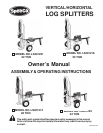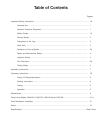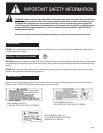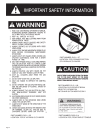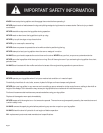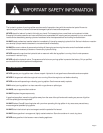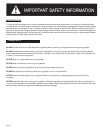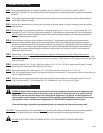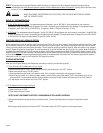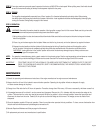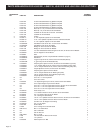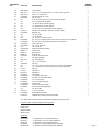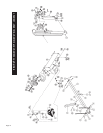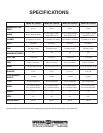
STEP 3: The engine maximum governed speed is preset at the factory at 3600 RPM no load speed. When splitting wood, the throttle should
be set at the maximum setting to develop the horsepower required for the pump.
STEP 4: TOWING
The log splitter is equipped with pneumatic tires, a Class I coupler (2 in. diameter ball required) and safety chains. Before towing,
the safety chains must be secured to the hitch or bumper of the vehicle. Local regulations should be checked regarding licensing, lights,
towing, etc. See also Towing Safety on page 6 of this manual.
STEP 5: OPERATION
1) Set up the log splitter in a clear, level area and block the wheels. Make sure that the suction port on the tanks is always on the lower
side of the log splitter.
2) Place a log on the beam against the foot plate. Make sure that the log is securely on the foot plate and up against the beam.
3) Depress the valve handle so that the cylinder will drive the wedge into the log. Extend the cylinder until the log splits or to the
end of its stroke. If the log has not completely split after the cylinder has reached the end of its extension, retract the cylinder.
IMPORTANT: Leaving the valve in the “actuate” position at the end of the stroke may damage the pump. Always use extra care
when splitting logs with unsquare ends.
NOTE: For operation in wooded areas, obtain a spark arrestor for the exhaust system. See the engine operating and maintenance manual
and check with your authorized Briggs & Stratton service center. See also Fire Prevention on page 5 and 6 of this manual.
IMPORTANT: TO EXTEND THE LIFE OF THE HYDRAULIC CYLINDER, AVOID “BOTTOMING OUT” WEDGE PLATE TO THE FOOT
PIECE. TO CONFORM WITH INDUSTRY SAFETY RECOMMENDATIONS, THE WEDGE STOPS 2 INCHES FROM
THE END OF THE STROKE.
MAINTENANCE
1) Consult the operating and maintenance instructions of the engine manufacturer for engine care and maintenance.
2) Always check the oil level of the hydraulic reservoir before operation. Operating the log splitter without an adequate oil supply
will cause severe damage to the pump.
3) Change the oil filter after the first 25 hours of operation. Thereafter, change the oil filter every 100 hours or seasonally, whichever comes first.
4) If the wedge becomes dull or nicked, it can be removed and sharpened. Remove the 1/2 in. diameter bolt that connects the wedge to the
cylinder. The hose from the valve may need to be removed. While the log splitter is in the horizontal position, loosen the hose clamp and
disconnect the hose from the valve. Carefully lift the cylinder to allow the wedge to slide forward. The wedge can now be lifted off and
sharpened.
5) Clean the breather cap after 25 hours of operation. Clean it more often when operated in dusty conditions. To clean, remove the breather from
the tank and flush with kerosene or liquid detergent to remove the dirt.
6) See also Repair and Maintenance Safety on page 4 of this manual.
7) All replacement parts must meet manufacturer’s specifications.
Page 9
WARNING: See safety information related to operation of the log splitter on page 3 and 4 of this manual. Make sure that you have the
recommended personal protective equipment described on page 1.



